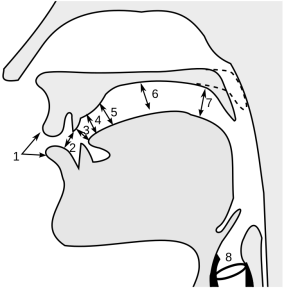When I started learning languages (being British) I had never heard so much as a single mention of IPA or other such linguistic terminology like Place/Manner of Articulation in my language classes. Figuring that there might be a lot of you out there in the same position as I was, I thought I’d do a simple guide to these words and what they mean on our blog.
As promised, here is the second part of the way we create consonant sounds in English. In this post I will explain manner of articulation, the second step vital to creating consonant sounds in English.
So, what is Manner of Articulation?
Well I’m glad you asked! You might remember from our last post that place of articulation is where we obstruct air flowing when we create a consonant (e.g. by bringing both of our lips together/by bringing our tongue to the roof of our mouth etc.). Well manner of articulation is quite simply how much air we obstruct when we make a sound.
In English there are 6 manners of articulation.
These are: Nasal
Plosive/Stop
Fricative
Affricate
Approximant
Lateral
 Once again I really encourage you to say these sounds as you learn about them to help you understand what I’m talking about. And with that, let’s get started! 🙂
Once again I really encourage you to say these sounds as you learn about them to help you understand what I’m talking about. And with that, let’s get started! 🙂
1) Nasal
Nasal consonants occur when you completely block airflow through your mouth (by bringing both your lips together and using the bilabial place of articulation) and let the air flow through your nose.
These sounds are:
[m] (as in moist)
[n] (as in noodle)
[ŋ] (as in minger)
2) Plosive/Stop
Plosive (also known as stop) sounds are created when airflow is completely blocked for a moment, building up pressure behind the articulators, before the air is then released in one quick burst.
These sounds are:
[b] (as in bobble)
[p] (as in pebble)
[d] (as in doddle)
[t] (as in toddler)
[k] (as in sock)
[g] (as in gaggle)
3) Fricative
Fricative sounds are made when air is only partially obstructed on its way through the vocal tract. This then forces air to flow down a much more restricted channel, causing a sound created in part by friction (hence fricative).
These sounds are:
[f] (as in kerfuffle)
[v] (as in vulcanodon)
[s] (as in slobber)
[z] (as in zesty)
[ʃ] (as in shingle)
[ʒ] (as in measure)
[θ] (as in Thor)
[ð] (as in rather)
4) Affricate
Affricate consonants happen when there’s basically a mash-up of stop and fricative consonants.
These sounds are:
[tʃ] (as in chunder)
[dʒ] (as in bodge tape)
5) Approximant
Approximant sounds are a bit of a grey area. You may quite rightly have noticed in my last post that the Standard English [ɹ] as in ‘run’ sound was not included and that [w] as in ‘water’ was placed as a velar sound despite also using your lips. Furthermore [j] as in ‘yes’ was considered palatal despite the fact that your tongue never really touches your hard palate when creating that sound, just comes very close.
Well these are all approximant sounds, meaning that two articulators will come close together, but not close enough to touch, and not close enough to create turbulent air like a fricative.
These sounds are:
[ɹ] (as in rambunctious)
[w] (as in dweeb)
[j] (as in yodel)
6) Lateral
Lastly, lateral sounds are created when your tongue obstructs air from passing through the centre of your mouth, causing it to go around the sides.
The only sound like this in English is:
[ɫ] or [l] (as in lobular)
So that is manner of articulation for consonants in English. In next week’s post I will cover voicing, place/point of articulation for vowels and a few loose odds and ends (such as why ‘h’ isn’t included on this post) as well. That post will conclude the set of Confusing Linguist Terminology: English posts and then we will move onto a new language. See you then! 🙂
